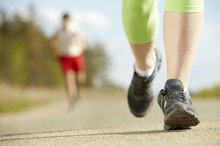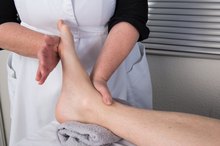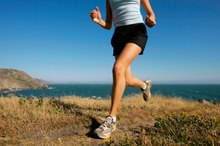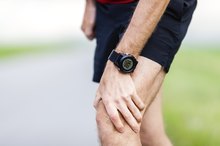Pain With Running on Hard Surfaces
Running offers benefits to your body, such as strengthening your heart and lungs and burning calories to help you maintain a healthy weight. But running can take a toll. The repetitive strain on your body, starting from your feet all the way to your lower back, can cause aches and pains. This can be especially true if you run on hard surfaces, such as concrete.
Hard Surface’s Effect
Running involves your feet repetitively striking the ground, absorbing shock through your foot to your knees, hips and lower back. When your feet strike a hard surface like concrete, the ground does not absorb any of the shock; instead, this vibration is reflected up through the foot at a greater intensity than if you were running on a surface like an indoor track intended for running or a treadmill. Over time, the impact from running on hard surfaces can translate into increased injury risk.
Injury Examples
Leg Pain Below the Knee
Learn More
Frequently running on hard surfaces can lead to inflammation like Achilles tendonitis, a condition where the tendon that connects the heel bone to your lower leg becomes inflamed, causing heel pain. Hard surfaces also can cause shin splints, an inflammation of the tendons and muscles in the front and outside of the leg. Fat pad impingement occurs when the cushioning fat pad underneath the kneecap becomes wedged between the kneecap and the lower leg bone, or tibia. This can occur when the leg is straightened and your foot hits the hard surface. Repetitive impact also can lead to stress fractures in the small bones of the foot or ankle, which can ultimately result in significant breakage.
- Frequently running on hard surfaces can lead to inflammation like Achilles tendonitis, a condition where the tendon that connects the heel bone to your lower leg becomes inflamed, causing heel pain.
Treatment
If you experience pain after running, rest your legs and ice any areas where you feel pain. Taking an anti-inflammatory medication such as ibuprofen also can help. You do not have to eliminate running on hard surfaces entirely: Instead, try to alternate days where you run on harder surfaces with a day spent running on a treadmill, indoor track or gym floor built to absorb shock. Purchasing new shoes with supportive heel or wearing a custom-fitted orthotic or heel pad also may help your foot better absorb shock from hard surfaces.
- If you experience pain after running, rest your legs and ice any areas where you feel pain.
- Purchasing new shoes with supportive heel or wearing a custom-fitted orthotic or heel pad also may help your foot better absorb shock from hard surfaces.
Warning
Running and Bruising on the Sole of My Foot
Learn More
If you continue to experience pain while running on hard surfaces after two to three weeks of home treatment, see your doctor. Pain that seems to be getting worse or developing additional symptoms also can indicate the need to see a physician. He can evaluate you to ensure your pain is not because of an underlying condition that must be treated using medications, physical therapy or surgery.
Related Articles
References
- MedlinePlus: Heel Pain
- American Academy of Podiatric Sports Medicine: Running and Your Feet
- Cool Running; Lower Leg Pain; Josh Clark; Deceember 1997
- Sports Injury Clinic: Fat Pad Impingement
- Alfredson, H., & Cook, J. (2007). A treatment algorithm for managing Achilles tendinopathy: new treatment options. British journal of sports medicine, 41(4), 211–216. doi:10.1136/bjsm.2007.035543
- Bass E. Tendinopathy: why the difference between tendinitis and tendinosis matters. International journal of therapeutic massage & bodywork, 5(1), 14–17.
- Beals, C., & Flanigan, D. (2013). A Review of Treatments for Iliotibial Band Syndrome in the Athletic Population. Journal of sports medicine (Hindawi Publishing Corporation), 2013, 367169. doi:10.1155/2013/367169
- Fredericson, M., & Wolf, C. (2005). Iliotibial Band Syndrome in Runners. Sports Medicine, 35(5), 451–459. doi:10.2165/00007256-200535050-00006
- Lavine R. (2010). Iliotibial band friction syndrome. Current reviews in musculoskeletal medicine, 3(1-4), 18–22. doi:10.1007/s12178-010-9061-8
- Li, H. Y., & Hua, Y. H. (2016). Achilles Tendinopathy: Current Concepts about the Basic Science and Clinical Treatments. BioMed research international, 2016, 6492597. doi:10.1155/2016/6492597
- Lopez, R. G., & Jung, H. G. (2015). Achilles tendinosis: treatment options. Clinics in orthopedic surgery, 7(1), 1–7. doi:10.4055/cios.2015.7.1.1
- Schwartz, E. N., & Su, J. (2014). Plantar fasciitis: a concise review. The Permanente journal, 18(1), e105–e107. doi:10.7812/TPP/13-113
- Shamus, J., & Shamus, E. (2015). THE MANAGEMENT OF ILIOTIBIAL BAND SYNDROME WITH A MULTIFACETED APPROACH: A DOUBLE CASE REPORT. International journal of sports physical therapy, 10(3), 378–390. PMID: 26075154
- Warren, B. L. (1990). Plantar Fasciitis in Runners. Sports Medicine, 10(5), 338–345. doi:10.2165/00007256-199010050-00004\
Writer Bio
Rachel Nall began writing in 2003. She is a former managing editor for custom health publications, including physician journals. She has written for The Associated Press and "Jezebel," "Charleston," "Chatter" and "Reach" magazines. Nall is currently pursuing her Bachelor of Science in Nursing at the University of Tennessee.







